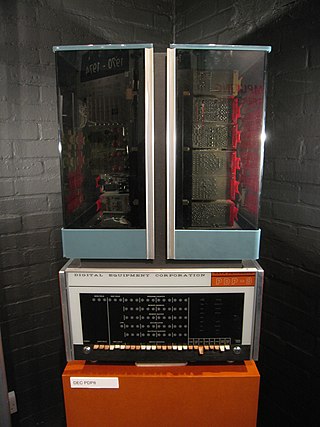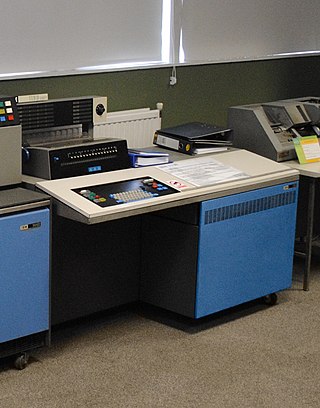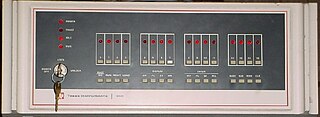| Original author(s) | Dale Skrien [1] |
|---|---|
| Stable release | 4.0.11 / August, 2017 |
| Written in | Java |
| Operating system | MS-Windows, Linux, Mac (Cross-platform) |
| Type | IDE |
| License | GPLv3+ |
| Website | www |
CPU Sim is a software development environment for the simulation of simple computers. It was developed by Dale Skrien to help students understand computer architectures. With this application the user is able to simulate new or existing simple CPUs. Users can create new virtual CPUs with custom machine language instructions, which are implemented by a sequence of micro instructions. CPU Sim allows the user to edit and run assembly language programs for the CPU being simulated.
CPU Sim has been programmed using the Java Swing package. This means that it is platform independent (runs on every platform that has a Java virtual machine installed).
A sample computer system, the Wombat 1, is provided with CPU Sim. It has the following registers:
The assembly language of the Wombat 1 computer consists of 12 instructions. Each instruction is stored on 16 bits; the first 4 are the opcode and the other 12 are the address field.
| Mnemonic | Operation code | Field length | Meaning |
|---|---|---|---|
| stop | 0 | 16 | stops the program execution |
| load | 1 | 4 12 | transfers data from memory to the accumulator |
| store | 2 | 4 12 | transfers data from the accumulator to memory |
| read | 3 | 4 (12) | puts the data from the IO console to the accumulator |
| write | 4 | 4 (12) | sends the data from the accumulator to the IO console |
| add | 5 | 4 12 | adds the data from memory to the accumulator and the result is then stored in the accumulator |
| subtract | 6 | 4 12 | subtracts the data from memory from the accumulator and the result is then stored in the accumulator |
| multiply | 7 | 4 12 | multiplies the data from the memory by the accumulator and the result is then stored in the accumulator |
| divide | 8 | 4 12 | divides the data from the memory into the accumulator and the result is then stored in the accumulator |
| jmpz | 9 | 4 12 | jump to address if the accumulator is 0 |
| jmpn | A | 4 12 | jump to address if the accumulator is negative |
| jump | B | 4 12 | unconditioned jump to address |
CPU Sim has the following features:
This program reads in integers until a negative integer is read. It then outputs the sum of all the positive integers.
Start: read // read n -> acc jmpn Done // jump to Done if acc < 0. add sum // add sum to the acc store sum // store the new sum jump Start // go back & read in next number Done: load sum // load the final sum write // write the final sum stop // stop sum: .data 2 0 // 2-byte location where sum is stored
The following modification of the program is also used sometimes:
Start: read // read n -> acc jmpz Done // jump to Done if nacc is 0. add sum // add sum to the acc store sum // store the new sum jump Start // go back & read in next number Done: load sum // load the final sum write // write the final sum stop // stop sum: .data 2 0 // 2-byte location where sum is stored
This one can use negative input to subtract, or 0 to break the loop.

The Data General Nova is a series of 16-bit minicomputers released by the American company Data General. The Nova family was very popular in the 1970s and ultimately sold tens of thousands of units.
In processor design, microcode serves as an intermediary layer situated between the central processing unit (CPU) hardware and the programmer-visible instruction set architecture of a computer, also known as its machine code. It consists of a set of hardware-level instructions that implement the higher-level machine code instructions or control internal finite-state machine sequencing in many digital processing components. While microcode is utilized in general-purpose CPUs in contemporary desktops, it also functions as a fallback path for scenarios that the faster hardwired control unit is unable to manage.
MIPS is a family of reduced instruction set computer (RISC) instruction set architectures (ISA) developed by MIPS Computer Systems, now MIPS Technologies, based in the United States.

In computer programming, machine code is computer code consisting of machine language instructions, which are used to control a computer's central processing unit (CPU). Although decimal computers were once common, the contemporary marketplace is dominated by binary computers; for those computers, machine code is "the binary representation of a computer program which is actually read and interpreted by the computer. A program in machine code consists of a sequence of machine instructions ."
MMIX is a 64-bit reduced instruction set computing (RISC) architecture designed by Donald Knuth, with significant contributions by John L. Hennessy and Richard L. Sites. Knuth has said that,
MMIX is a computer intended to illustrate machine-level aspects of programming. In my books The Art of Computer Programming, it replaces MIX, the 1960s-style machine that formerly played such a role… I strove to design MMIX so that its machine language would be simple, elegant, and easy to learn. At the same time I was careful to include all of the complexities needed to achieve high performance in practice, so that MMIX could in principle be built and even perhaps be competitive with some of the fastest general-purpose computers in the marketplace."

The PDP-8 is a family of 12-bit minicomputers that was produced by Digital Equipment Corporation (DEC). It was the first commercially successful minicomputer, with over 50,000 units being sold over the model's lifetime. Its basic design follows the pioneering LINC but has a smaller instruction set, which is an expanded version of the PDP-5 instruction set. Similar machines from DEC are the PDP-12 which is a modernized version of the PDP-8 and LINC concepts, and the PDP-14 industrial controller system.
A one-instruction set computer (OISC), sometimes referred to as an ultimate reduced instruction set computer (URISC), is an abstract machine that uses only one instruction – obviating the need for a machine language opcode. With a judicious choice for the single instruction and given arbitrarily many resources, an OISC is capable of being a universal computer in the same manner as traditional computers that have multiple instructions. OISCs have been recommended as aids in teaching computer architecture and have been used as computational models in structural computing research. The first carbon nanotube computer is a 1-bit one-instruction set computer.
MIX is a hypothetical computer used in Donald Knuth's monograph, The Art of Computer Programming (TAOCP). MIX's model number is 1009, which was derived by combining the model numbers and names of several contemporaneous, commercial machines deemed significant by the author. Also, "MIX" read as a Roman numeral is 1009.
x86 assembly language is the name for the family of assembly languages which provide some level of backward compatibility with CPUs back to the Intel 8008 microprocessor, which was launched in April 1972. It is used to produce object code for the x86 class of processors.
A processor register is a quickly accessible location available to a computer's processor. Registers usually consist of a small amount of fast storage, although some registers have specific hardware functions, and may be read-only or write-only. In computer architecture, registers are typically addressed by mechanisms other than main memory, but may in some cases be assigned a memory address e.g. DEC PDP-10, ICT 1900.

The IBM 1130 Computing System, introduced in 1965, was IBM's least expensive computer at that time. A binary 16-bit machine, it was marketed to price-sensitive, computing-intensive technical markets, like education and engineering, succeeding the decimal IBM 1620 in that market segment. Typical installations included a 1 megabyte disk drive that stored the operating system, compilers and object programs, with program source generated and maintained on punched cards. Fortran was the most common programming language used, but several others, including APL, were available.
The Simplified Instructional Computer is a hypothetical computer system introduced in System Software: An Introduction to Systems Programming, by Leland Beck. Due to the fact that most modern microprocessors include subtle, complex functions for the purposes of efficiency, it can be difficult to learn systems programming using a real-world system. The Simplified Instructional Computer solves this by abstracting away these complex behaviors in favor of an architecture that is clear and accessible for those wanting to learn systems programming.

The COSMAC is an 8-bit microprocessor family introduced by RCA. It is historically notable as the first CMOS microprocessor. The first production model was the two-chip CDP1801R and CDP1801U, which were later combined into the single-chip CDP1802. The 1802 represented the majority of COSMAC production, and today the entire line is known simply as the RCA 1802.
An instruction set simulator (ISS) is a simulation model, usually coded in a high-level programming language, which mimics the behavior of a mainframe or microprocessor by "reading" instructions and maintaining internal variables which represent the processor's registers.
NAR 1 or just NAR was a theoretical model of a computer created by Faculty of Mathematics of University of Belgrade professor Nedeljko Parezanović. It was used for Assembly language and Computer architecture courses.

The TI-990 was a series of 16-bit minicomputers sold by Texas Instruments (TI) in the 1970s and 1980s. The TI-990 was a replacement for TI's earlier minicomputer systems, the TI-960 and the TI-980. It had several unique features, and was easier to program than its predecessors.

In computing, an emulator is hardware or software that enables one computer system to behave like another computer system. An emulator typically enables the host system to run software or use peripheral devices designed for the guest system. Emulation refers to the ability of a computer program in an electronic device to emulate another program or device.
MikroSim is an educational software computer program for hardware-non-specific explanation of the general functioning and behaviour of a virtual processor, running on the Microsoft Windows operating system. Devices like miniaturized calculators, microcontroller, microprocessors, and computer can be explained on custom-developed instruction code on a register transfer level controlled by sequences of micro instructions (microcode). Based on this it is possible to develop an instruction set to control a virtual application board at higher level of abstraction.
RISC-V is an open standard instruction set architecture (ISA) based on established reduced instruction set computer (RISC) principles. Unlike most other ISA designs, RISC-V is provided under royalty-free open-source licenses. Many companies are offering or have announced RISC-V hardware; open source operating systems with RISC-V support are available, and the instruction set is supported in several popular software toolchains.
The Hack Computer is a theoretical computer design created by Noam Nisan and Shimon Schocken and described in their book, The Elements of Computing Systems: Building a Modern Computer from First Principles. In using the term “modern”, the authors refer to a digital, binary machine that is patterned according to the von Neumann architecture model.